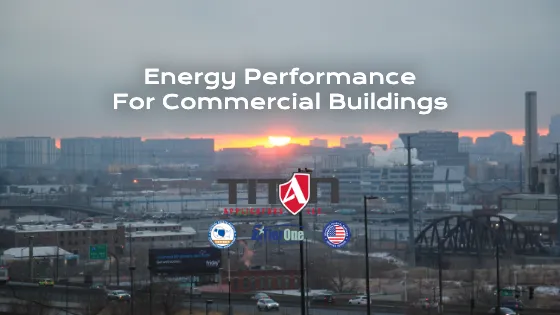A flat roof or low-slope roof over a large commercial or industrial building is the most effective part in conserving energy. If designed properly, the roofing system can mitigate a facility’s energy loss or gain and support a building’s mechanical system to operate properly.
Why is that important? There is a nationwide push to help decrease global emissions. As a result, states and municipalities are committing themselves to pollution reduction targets. President Joe Biden recently committed to other world leaders, through the Paris Agreement, that the United States will be a Net-Zero Emissions Economy by no later than 2050.
Here in Colorado, House Bill 21-1286, “Energy Performance for Buildings,” passed the Colorado General Assembly in the summer of 2021. This bill requires owners of large commercial, multifamily, and public buildings 50,000+ square feet to report their annual energy use to the Colorado Energy Office (CEO). Using the gathered data, the law establishes a building performance standards with which buildings, and building owners, will have to comply. - All in an effort to meet state-wide greenhouse gas (GHG) reduction targets of 7% by 2026 and 20% by 2030.

What does HB 21-1286 Mean For Building Owners?
The Ugly: With every regulation comes consequence of noncompliance and although Colorado legislators are still in the early stages of concept, we can look to other municipalities, counties, and states for what may be coming to The Centennial State. In Washington DC, for instance, legislators have been clear that they intend to set penalties higher than the cost of compliance.
The Bad: Getting buy-in to a new and mandatory government regulation is never something people will throw a parade for. It will be interesting to see how the Colorado regulatory body enforces and, most importantly, offers technical assistance for commercial building owners throughout this process. Skepticism will spread like a wild-fire at the first sign of DMV-like service.
The Good: Obviously the goal is to ensure a better future for our kids by reducing and/or eliminating greenhouse gas pollution. From a business perspective, rather, the greatest opportunity lies with building owners and real estate professionals who haven’t previously tracked their energy use. By means of intervention, albeit forced, owners and managers will have an opportunity to to identify and prioritize cost-effective opportunities to make maximize profits in their portfolios.
The roof over your commercial building has the greatest impact on the energy performance of your building. The good news - there are options fully restore your existing roof, significantly increase its’ energy efficiency, and avoid the high costs of replacing it.
What Is A Net Zero Building?
The City of Denver defines “Net Zero Energy” (NZE) as a building or home that is:
- Highly energy efficient
- All electric
- Powered by renewable energy
- Providers of demand flexibility for the power grid.
As with most things, the devil in the details. The correlation between energy conservation and an effective thermal layer on a roof has been improved through building standards and codes but we still have a long way to go.

What Is The Best Commercial Roof To Reduce Carbon Emissions?
When we talk about the roofs over commercial and industrial facilities, we are talking about systems, or whole assemblies, not just the material you see from the top. Thus, with each flat-roofing system, there are many different parameters that need consideration to achieve the same results:
- air and vapor barriers
- transitions
- penetrations
- roof edges
- insulation
- fasteners
- adhesives
Just as an individual musician has the opportunity to make an impact on our world, each individual roofing component has an important job on your building. But, when you select and appoint the right group of musicians, the result is a symphony. In commercial roofing, the right roofing systems perform much better than others.
The Effects of Cool Roofs On Energy Efficient Building Design
Many methods have been deployed to reduce a building’s energy usage. One such method is the idea referred to as “cool roofs.” The idea is that light-colored roof coverings, usually single-ply membranes, are more reflective and will reduce the energy consumption of a building.
But are Cool Roofs just a cool name used to sell the consumer to make them feel warm and fuzzy inside?
Like most things, the intent behind the idea is well intended but the true meaning gets lost in translation. For example, every year thousands of commercial building owners in Colorado purchase mechanically fastened white TPO membrane roofs that have the “Green Roof” stamp of approval. Sure, they are reflective, but is the overall roof design actually helping the environment? A 2014 white paper issued by the Symposium on Building Envelope Technology [The Energy Penalty Associated With The Use Of Mechanically Attached Roofing Systems] demonstrates otherwise.

“Mechanically attached roofing systems with thermoplastic membranes have been observed to be affected by indoor air intrusion, which occurs when indoor air is driven into and exchanged inside a building component without escaping the component. Air intrusion is mainly a result of wind-induced air pressure differences over the roof assembly and the air permeability of the roof components underneath the surface membrane. Because of the flexibility and elasticity of the exterior surface membrane, air pressure differences cause the membrane to flutter, which in turn draws air from the indoor environment toward the interior side of the surface membrane…
Cool roofs with mechanically attached membranes have been proved to pose more risk to moisture durability (i.e., a risk of intermediate condensation underneath the surface membrane) than roofing systems with traditional dark surface colors, primarily because of air intrusion.”
The point: there are many factors to consider other than cool-colored roof surfaces and it is imperative that owners work with professional roofing contractors of experience.
See how Spray Foam Roofing Systems are the perfect Cool Roof system for flat or low-sloped roofs.







